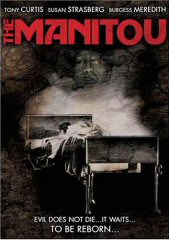
After unleashing the nature-amuck thrills of Grizzly and Day of the Animals on the 70s Drive-In crowd, pulp director extraordinare William Girdler sought inspiration in bestselling pulp author Graham Masterton's The Manitou, a novel combining ancient Native American occult beliefs with technology and our universal fear of both the unknown and the human body. A strange, fascinating, albeit uneven product, Girdler achieved the eldritch nightmare tone of the novel in his adaptation but failed to inspire the author's empathy with characters. This, coupled with lackluster effects work, particularly at the end, diminish something of the film's unique and chilling premise of a Shaman's spectral revenge against the race that tormented his own. An aesthetic failure, the film is nevertheless enjoyable, featuring several memorable performances, unintentional humor, and moments of terror to be summarily dismissed.
Featured in a re-mastered print from Anchor Bay, dark fantasy aficionados can take a trip down memory lane with a movie that emphasizes both the skill and faults of its workman-like director.
The plot for The Manitou is surprisingly thoughtful and culturally relevant, inviting reflection on the atrocities the West committed against the Indians during the shameful beginnings of our expansion. These points are stressed -- and add strength -- to the dark magic and demonic wrath of the central conflict as Misquamacus, a Medicine Man, wages vengeance against the White Man who destroyed his way of life. When Karen Tandy (Susan Strasberg) is diagnosed with a malignant fast-growing tumor on her neck by doctors stumped by its strange behaviour and deadliness, she calls on the skills of Harry Erskine, a 'fake' psychic played with panache by legendary Tony Curtis. When the operation to move the tumor fails due to occult complications, Harry finds himself facing an ancient evil in his quest to trace precisely what is endangering his lady's life. He must face his own unsuspected occult ability as he battlers the physical manifestation of Misquamacus, an ancient Indian re-entering the physical world through the flesh of an innocent. When Harry enlists the help of a living Shaman, John Singing Rock (Michael Ansara), the spiralling tragedy becomes a surreal battle between science and mysticism whose ideas prove grander than their final conception.
An admittedly populist filmmaker, Girdler was also a craftsman seeking ways to cut corners due to budgetary restraints; this same necessity also led to ingenuity in terms of his FX and compositions, suggesting that he, like other before him, are at their best when against the wall. In Masterton's Manitou he crafts an exciting surface entertainment of cheap but effective chills, yet fails to keep the pace moving at a suspenseful tempo. He also depends overly much on lackluster effects whose amateur look feels more like cheap imitation "Star Wars' than supernatural chiller. The computer effects near the film's end, tacked on in a generation in love with space opera spectacle, are a disappointment, as was, to be fair, Masterton's decision to depict technology as victorious over Native American magic. The most effective moments of drama and horror are those embedded in the cultural clash between the White Man and the Indian, the abuses of history and hypocrisy of a self-satisfied modernity. Each of these is further embodied by the tension between Western technology and Native demonology. You may find yourself rooting with the Manitou -- I sure did. Either way, Girdler retains his title as the archetypal low budget poet of poverty productions. For all its faults in conception and production, The Manitou entertains as exploitation, and should be amusing for younger fans as a time capsule of 70s clothing styles, bad hair, and low budget shocks.
This 1978 thriller is given an admirable widescreen (2.35:1, 16x9 enhanced) transfer. This print is clean and crisp, polishing many of the splices -- and much of the grain -- that existed in pervious prints. Audio is clean and concise, without significant distortions, and the 'trippy' score clearly audible. Extras are bare bones, consisting of a Theatrical Trailer and TV Spot.
Review by William P. Simmons
| Released by Anchor Bay |
| Region 1 - NTSC |
| Not Rated |
| Extras : |
| see main review |